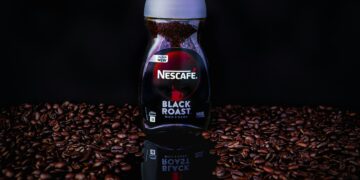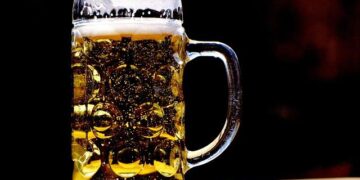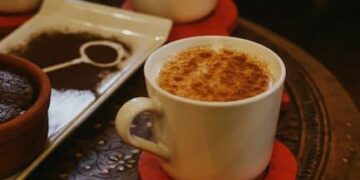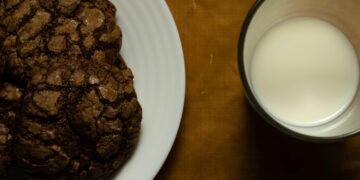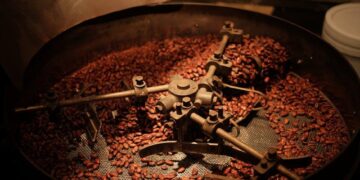Table of Contents
Part I: The Crime Scene
Opening Scene: The Murky Glass
It begins, as these things often do, with the promise of perfection.
A bag of freshly roasted beans, selected specifically for their cold brew potential—low in acidity, high in sugar browning, ready to yield a smooth, sweet elixir.1
The grinder is set to its coarsest setting, the water is filtered, the ratio is precise, and the steeping vessel is immaculate.
For 18 long hours, patience is the primary ingredient.
The anticipation builds.
This time, it will be different.
This time, it will be perfect.
And then, the denouement.
The moment of truth arrives not with a triumphant sip, but with a silent, sinking feeling.
The resulting liquid is a study in contradictions.
It is a glass of profound disappointment.
The first offense is visual.
The coffee is not the deep, clear mahogany seen in cafes, but a cloudy, turbid mess.
It’s what some have aptly described as “slushy and murky”.2
A fine, gritty layer of silt has already begun to settle at the bottom of the glass, a telltale sign of a filtration failure.
The second offense is textural.
The first sip confirms the visual evidence: a thin, almost watery body that is simultaneously gritty, leaving behind a chalky residue on the tongue.
It lacks the silky, full-bodied mouthfeel that is the hallmark of great cold brew.
The final, fatal blow is the flavor.
Instead of the smooth, mellow, chocolatey notes promised by the slow, heatless extraction, the brew is somehow both weak and bitter.
It’s a ghost of the coffee it was meant to be, a hollow echo of flavor undermined by a harsh, unpleasant edge.
This is the crime scene.
A carefully planned process has ended in a disastrous outcome.
The evidence is all there in the murky glass.
The frustration is palpable, a feeling shared by countless home brewers who have found themselves staring into a similar abyss of failure.
They followed the rules.
They bought the right gear.
They waited.
And for what? For a “painfully slow” drip that clogs the filter and chokes the life out of the brew.3
For a “thick mud” that refuses to yield its liquid gold.3
For a brew so weak it’s barely recognizable as coffee.5
The question that hangs in the air, thick as the sludge in the cup, is the one that sets every investigation in motion: “What am I doing wrong?”.6
The Clogging-Sludge Paradox
The initial investigation into this brewing disaster reveals a fundamental, maddening paradox.
The problem seems to be a simple one of filtration, but the two most common solutions appear to be mutually exclusive, trapping the brewer in a frustrating catch-22.
The quest to solve one problem—the gritty sludge—directly and inevitably creates another: the infuriating clog.
Consider the two primary suspects: the paper filter and the metal filter.
In an effort to achieve a perfectly clean, sediment-free cup, the logical first step is to use a paper filter.
Its tightly woven fibers are designed to trap even the finest particles, promising a brew of exceptional clarity.7
But as many a brewer has discovered, this promise comes at a steep price.
The very properties that make paper so effective at capturing sediment also make it exquisitely prone to clogging, especially with the fine particulate matter inherent in cold brew.
The flow starts, then slows, then stops entirely, leaving a pool of coffee sitting stubbornly atop a choked filter.4
The process becomes a tedious, time-consuming nightmare.
Frustrated by the clog, the brewer then pivots to the opposite solution: a reusable metal mesh filter.
The problem of clogging is instantly solved.
Water flows through the metal mesh with ease, and the filtration is swift.
But the victory is short-lived.
The resulting brew is a return to the original crime scene: a cup marred by a layer of fine sediment, the dreaded sludge that the paper filter was meant to eliminate.10
The metal filter, with its larger pores, allows not only the flavorful oils to pass through but also a significant amount of micro-grounds, resulting in a gritty texture.12
This is the Clogging-Sludge Paradox.
The tool that promises clarity creates a blockage.
The tool that promises flow creates a mess.
The home brewer is caught between a filter that won’t drain and a filter that won’t truly filter.
It becomes clear that the initial line of inquiry was flawed.
The search for a single, perfect filter is a fool’s errand.
The problem is not with the tools themselves, but with a fundamental misunderstanding of the forces at play.
The true culprit is something deeper, something that requires a more forensic approach to uncover.
Part II: The Investigation – Uncovering the Evidence
Ruling Out the Usual Suspects
Every good investigation begins by methodically ruling out the obvious.
Before condemning the filter, it is necessary to ensure that no other variable is contaminating the crime scene.
The coffee beans themselves are interrogated first.
They are high-quality, single-origin beans, specifically sourced and roasted for cold brew, known for their low acidity and rich, sweet profiles.1
They are innocent.
The water is next.
It is filtered, free of the impurities that could mar the final taste.
It, too, is cleared.
The ratio of coffee to water is checked against established best practices—typically around 1 ounce of coffee per cup of water, a stronger ratio than for drip coffee.14
The steep time, a critical factor, falls squarely within the recommended 12 to 24-hour window, the accepted standard for a proper cold extraction.15
With these primary variables exonerated, the investigation narrows, zeroing in on the physical act of filtration itself.
The focus shifts to the tools of the trade and the messy evidence they leave behind: the clogged paper, the gritty sludge, the failed brew.
The time has come to examine the exhibits one by one.
Exhibit A: The Paper Filter (The Clogged Drain)
The first piece of evidence under review is the common paper filter.
Whether it’s a cone-shaped filter designed for a pour-over dripper or a flat-bottomed basket filter for an automatic machine, the story is tragically the same.17
The process begins with a sense of optimism.
The cold brew concentrate is poured into the filter, and for a brief, glorious moment, a steady stream of clean, dark liquid drips into the carafe below.
But then, the flow falters.
The drip slows to a trickle, and then, silence.
The coffee simply sits in the filter, a stagnant pool held hostage by an invisible barrier.3
The frustration mounts.
In a desperate attempt to salvage the batch, the brewer might try to replace the filter, carefully pouring the remaining slurry into a fresh one.
The result is a cruel joke: the new filter “immediately clogs up again”.4
The fine particles suspended in the liquid, the very “mud” the filter is supposed to catch, form a dense, impermeable layer on the paper’s surface, bringing the entire operation to a grinding halt.
To add insult to injury, there is the matter of taste.
If an unbleached paper filter is used without a preliminary rinse, it can impart a distinct and unpleasant “papery” or “cardboard-like” flavor to the coffee, a subtle but significant flaw that can dull the delicate notes of a high-quality bean.17
Even bleached filters, which are treated to be more neutral, benefit from a rinse to remove any residual manufacturing compounds and to pre-heat the brewing vessel.20
The paper filter, once seen as the key to a clean cup, now looks like a prime suspect in the crime of a ruined brew.
Exhibit B: The Metal Filter (The River of Mud)
The investigation now turns to the second exhibit: the reusable metal filter.
Often made of stainless steel mesh, sometimes coated in gold and marketed as a “gold tone” filter, this option presents an attractive alternative.18
It is durable, eco-friendly, and eliminates the recurring cost of disposable paper filters.19
Most importantly, it does not clog.
The cold brew concentrate flows through it quickly and efficiently, a welcome relief after the agonizingly slow drip of its paper counterpart.
But the relief is fleeting.
The speed comes at a cost, and that cost is clarity.
The final cup is a return to the initial crime scene.
A fine layer of sediment, like river silt, settles at the bottom of the mug.
The coffee has a “gritty texture” 12, and while some might describe the flavor as “full-bodied” or “robust” due to the unfiltered oils, others find it “muddier” and less refined.24
For the brewer in pursuit of a clean, smooth cup, this is not a solution; it is merely a different kind of failure.
Furthermore, some metal filters can introduce their own unwanted flavors, imparting a “metallic, unpleasant taste” that interferes with the coffee’s natural profile.18
The metal filter, for all its convenience, leaves behind a trail of damning evidence in the bottom of the cup.
The Grind is the Unseen Accomplice
After examining both primary suspects—the paper filter and the metal filter—the investigation seems to have hit a wall.
Both have their fatal flaws.
But a closer look at the evidence, a re-examination of the “mud” and “silt” that causes both clogging and sludge, reveals a crucial clue.
The filter may be the weapon, but it is not the mastermind.
The filter is not acting alone.
There is an unseen accomplice: the coffee grind itself.
Across countless forums and discussions among experienced brewers, when a novice complains of a clogged filter or a sludgy cup, the first question is almost always the same: “What grinder are you using?”.3
This is the key that unlocks the entire case.
The true culprit is often not the filter, but the production of “fines”—the microscopic coffee particles generated during the grinding process.26
Even when set to a coarse setting, inconsistent grinders, particularly inexpensive blade grinders, shatter beans into a wide range of particle sizes.
Alongside the desirable coarse chunks, they create a significant amount of coffee dust.11
It is these fines, not the coarse grounds, that are the primary agents of filtration failure.
When using a paper filter, these tiny particles migrate through the larger grounds and form a dense, muddy layer directly on the paper’s surface, creating an impermeable barrier that water cannot penetrate.
This is the source of the clog.4
When using a metal filter, these same fines are small enough to pass right through the mesh along with the liquid, ending up as the gritty sludge at the bottom of the cup.10
This reframes the entire problem.
The issue is not a simple matter of choosing the right filter.
It is a more complex causal chain: the quality of the grinder determines the consistency of the grind and the percentage of fines produced.
The percentage of fines, in turn, dictates the performance of any given filter.
And the filter’s performance ultimately determines the quality of the final cup.
The filter has been taking the blame for a crime orchestrated by the grinder.
Any attempt to solve the filtration problem without first addressing the quality of the grind is doomed to fail.
This is the turning point in the investigation, the moment the case breaks wide open.
Part III: The Epiphany – A Journey into the Earth’s Crust
The “Aha!” Moment: From Coffee Filter to Aquifer
Frustration can be a powerful catalyst for insight.
Staring at the failed experiments—the clogged paper, the sludgy metal—the case felt cold.
The paradox seemed unbreakable.
The path forward was obscured by a fog of coffee fines.
And then, in a moment of serendipity, the answer arrived from an entirely unexpected place: not from a coffee blog or a barista’s manual, but from a documentary about geology.
The screen showed a cross-section of the Earth.
Rain fell, seeped into the ground, and began a long, slow journey downwards.
It percolated through distinct layers of rock and sediment: coarse gravel, porous sand, dense clay.
With each layer it passed, the water became cleaner, shedding its impurities, until it reached a vast underground reservoir, an aquifer, as pure, clean groundwater.29
The connection was instantaneous, an electrifying “aha!” moment.
The struggle in the kitchen was a perfect microcosm of this immense, planetary process.
The Earth doesn’t use a single, magical filter to purify its water; it uses a multi-stage system of layered materials, each with a different porosity and function.29
The reason my own filtration attempts were failing was because I was trying to force a single layer—a single filter—to do the work of an entire geological column.
The solution was not to find a better filter, but to build a better aquifer.
Deconstructing the Strata: A Geological Guide to Coffee Filters
This geological analogy became the key to deconstructing the entire problem.
Each type of coffee filter, with its unique properties and flaws, could be understood as a distinct sedimentary layer, performing a specific role in the great filtration journey.
The Gravel Layer (Metal Filters)
In nature, the first layer water often encounters is gravel.
Gravel is characterized by its large particles and the wide spaces between them, giving it high porosity and high permeability.
It acts as a coarse, preliminary screen, allowing water to flow through easily while physically trapping large debris like leaves, twigs, and other detritus.29
This is a perfect description of a metal coffee filter.
Its woven stainless-steel mesh has relatively large pores.
It excels at the “gravel” stage of filtration: it traps the bulk of the coarse coffee grounds while allowing the liquid—along with flavorful oils and fine sediment—to pass through with minimal resistance.7
The result is a brew that is analogous to river water after it has passed through a gravel bed: the big stuff is gone, but it’s still rich with suspended solids and dissolved minerals.
This creates a robust, full-bodied, and aromatic cup, but one that can be gritty and “unfiltered”.8
The Sandstone Layer (Cloth & Felt Filters)
Beneath the gravel, water percolates into layers of sand or porous sandstone.
The particles here are much smaller, and the spaces between them are tighter.
Filtration in this layer is more complex.
It still involves physical screening, but a second, crucial process comes into play: adsorption.
The surfaces of the sand grains can attract and hold onto finer impurities that are too small to be physically trapped.29
This is the world of cloth and felt filters.
Materials like cotton, hemp, or the unique polyester felt used in the Toddy system have a fibrous, complex structure that mimics a bed of sand.23
They are less permeable than a metal screen, effectively trapping the fine sediment and micro-grounds that a metal filter allows to pass.
However, unlike hyper-absorbent paper, they allow most of the flavorful coffee oils to remain in the brew.7
The result is a cup that strikes a beautiful balance—the “middle ground” that many brewers seek.
It is clean and smooth, free of sediment, yet it retains a medium body and the rich aromatics carried by the oils.7
It is the clean water of a natural spring, filtered through sandstone.
The Clay/Silt Layer (Paper Filters)
The final and most restrictive layer in a natural aquifer is often clay or silt.
Clay particles are microscopic and pack together so tightly that they have very low permeability.
Water struggles to pass through this dense layer, but in the process, it is polished to an exceptional degree of purity.
The clay traps the last remaining microscopic impurities, resulting in the cleanest possible water.29
This is, for better and for worse, the paper coffee filter.
Its tightly woven cellulose fibers and highly absorbent nature make it the ultimate barrier.7
It functions like a clay lens in the earth, trapping nearly everything—not just the finest sediment, but also the majority of the coffee’s natural oils.8
This produces a “hyper-clean,” “crisp,” and “bright” cup with unparalleled clarity, allowing the delicate floral and fruity notes of light-roasted beans to shine through without being masked by body or oils.19
But this extreme filtration comes at a price.
The low permeability that makes it so effective is the very reason it clogs so easily when overwhelmed by fines.
And by stripping out the oils, it can sometimes produce a cup that tastes “thin” or one-dimensional.
It is the purest water, but some might argue that it has been stripped of its character in the process.
Table: A Comparative Geology of Coffee Filters
To solidify this analogy into a practical framework, the characteristics of each filter type can be mapped directly to their geological counterparts.
This table transforms the metaphor into a functional guide for any brewer seeking to understand the tools at their disposal.
| Filter Type (Geological Layer) | Filtration Mechanism (How it Works) | Resulting Coffee (The Water) | Ideal For (The Ecosystem) |
| Metal (Gravel) | High permeability, physical screening. Traps large grounds, allows oils & fines through.7 | Rich, full-bodied, robust, aromatic. Can have sediment (“sludge”).8 | Dark roasts, coffees with nutty/chocolate notes, those who value durability and low waste.19 |
| Cloth/Felt (Sandstone) | Moderate permeability, adsorption & screening. Traps most fines, allows flavorful oils through.7 | Smooth, clean, balanced body, aromatic. The “middle ground” between clarity and richness.12 | Bright single-origins, those seeking a balance of clarity and body, eco-conscious users willing to do more cleaning.19 |
| Paper (Clay/Silt) | Low permeability, high adsorption. Traps almost all oils & fines.8 | Hyper-clean, crisp, bright acidity, high clarity. Can taste “thin.” Prone to clogging.4 | Light roasts, delicate floral/fruity coffees where absolute clarity is paramount. Maximum convenience.19 |
Part IV: Mastering the Flow – Engineering Your Personal Aquifer
The Solution: Multi-Stage Filtration
The epiphany was complete.
The forensic investigation had uncovered the core principles.
Now, all that remained was to apply them—to move from theory to practice, from geologist to engineer.
If nature uses multiple layers to achieve pure water, then the solution to the cold brew paradox must be to replicate that multi-stage process in the kitchen.
The approach is elegantly simple and directly addresses the fatal flaw of single-filter methods.
It is a two-step process, a technique that successful home brewers have discovered through experimentation and shared in their communities.2
Step 1: The Gravel Layer. The process begins with a coarse filtration stage.
After the coffee has finished steeping, the entire slurry—grounds and all—is first poured through a metal mesh strainer or the plunger of a French Press. This acts as the “gravel” layer, quickly and efficiently removing the bulk of the large coffee grounds.
The liquid that passes through is still cloudy with fines and rich with oils, but the vast majority of the solid mass has been left behind.
Step 2: The Sand/Clay Layer. The now pre-filtered coffee is then passed through a second, finer filter.
This can be a paper filter for ultimate clarity or a cloth filter for a balance of clarity and body.
Because the first stage has already removed most of the solids, this finer “sand” or “clay” layer is not overwhelmed.
The fine particles that would have instantly clogged it are far fewer in number, allowing the liquid to pass through at a steady, manageable rate.
The result is the holy grail that was so elusive at the start of the investigation.
It is the rich, full-bodied, and aromatic brew characteristic of a metal-filtered coffee, but polished to a perfectly clean, smooth, and sediment-free finish.
It is a cup with the complexity of a full extraction and the clarity of a meticulous filtration.
The paradox is solved.
The case is closed.
Case Study: The Toddy System as an Engineered Aquifer
Upon closer examination, it becomes clear that this principle of multi-stage filtration is not a new discovery.
It is, in fact, the secret behind one of the most iconic and successful cold brew systems on the market: the Toddy.
The Toddy system, at first glance a simple plastic bucket, is in fact a brilliant piece of hydrogeological engineering—a purpose-built, self-contained aquifer.
Its genius lies in its dual-filtration design, which perfectly mimics a natural layered system.38
- The Paper Filter Bag: The first component is the optional-but-highly-recommended paper filter bag.39 The coffee grounds are placed inside this large, disposable bag before water is added. The bag serves as the primary containment vessel and the initial filter. It functions as a combined “sand and gravel” layer, holding the vast majority of the coffee grounds and preventing most of the fines from ever migrating downwards into the rest of the system.
- The Felt Filter Disc: At the very bottom of the brewing container, sitting just above the drain plug, is a thick, reusable polyester felt disc.35 This is the system’s final polishing filter, its “clay” layer. After steeping, the coffee concentrate slowly percolates through the grounds contained in the paper bag and then passes through this felt disc before exiting the brewer. Because the paper bag has already done the heavy lifting of trapping the bulk of the grounds and fines, the felt filter is protected from clogging—a common problem that the dual-filter design is specifically intended to solve.40
The Toddy System’s Genius is Process, Not Just Parts
The true innovation of the Toddy system, however, goes beyond its physical components.
Its design guides the user, whether they realize it or not, into a hydrogeologically sound process.
The key lies in one simple, crucial instruction: when brewing without the paper filter bag, do not stir.3
This “no-stir” rule is a direct application of the geological principle of sedimentation.
When coffee grounds and water are mixed, the natural tendency is for the solids to settle out of the liquid over time.
Stirring agitates the mixture, creating a turbid slurry where fine particles are held in suspension, ready to be carried downwards and clog the filter.
By prohibiting stirring, the Toddy system encourages the grounds to settle naturally into a stratified bed.
The larger, coarser particles form a layer on top, and this bed of grounds itself becomes a natural pre-filter, trapping fines long before the liquid ever reaches the felt disc at the bottom.
This is the exact same epiphany that frustrated brewers discover on their own: the realization that gently pouring the water and leaving the grounds undisturbed is the secret to preventing a clog.3
The Toddy system is not just a collection of parts; it is an engineered ecosystem that forces the user to mimic the patient, gentle processes of nature, ensuring a successful filtration every time.
A Geologist’s Field Guide to Cold Brew
The forensic investigation is complete, the principles are understood, and the techniques are proven.
The path to the perfect cup of cold brew can now be summarized in a simple field guide, a set of best practices for the aspiring kitchen hydrogeologist.
- Control the Source Material (Grind Consistency): The entire process begins with the grind. A high-quality burr grinder is not a luxury; it is a necessity. A coarse, consistent grind minimizes the creation of “silt” (fines) from the outset, which is the single most important step in preventing both clogging and sludge.11
- Ensure Gentle Infiltration (No Stirring): Treat the brewing process like gentle rainfall, not a flash flood. Pour the water slowly and evenly over the grounds. Do not stir or agitate the slurry. This allows gravity and time to form a natural, stratified filter bed within the grounds themselves, which will act as your first and most effective filter.3
- Select Your Strata (Choose Your Filter Wisely): Use the geological analogy to make an informed choice. If you prefer a rich, full-bodied brew and don’t mind a little sediment, a “gravel” (metal) filter will suffice. If you seek the ultimate in clarity for a delicate, light roast, a “clay” (paper) filter is your tool. For a balance between the two, choose “sandstone” (cloth or felt). For the best of all worlds, engineer a multi-stage aquifer using a coarse filter first, followed by a fine one.23
- Maintain the Ecosystem (Proper Filter Cleaning): A clogged filter is a dead aquifer. Proper maintenance is essential for longevity and flavor purity. Paper filters are single-use. Cloth and felt filters should be rinsed thoroughly with water (no soap), squeezed of excess moisture, and stored in a sealed bag in the freezer to prevent microbial growth.35 Metal filters, over time, will become clogged with trapped coffee oils. They require periodic deep cleaning with a solution of hot water and vinegar, citric acid, or a specialized coffee equipment cleaner like Cafiza to dissolve the organic buildup and restore proper flow.45
Conclusion: The Wellspring
The journey that began with a murky, disappointing glass of coffee has come full circle.
The final cup, the result of this long forensic investigation, is a thing of beauty.
It is poured into a glass, and the liquid is a stunning, crystal-clear garnet.
There is no cloudiness, no silt, no sludge.
The aroma is complex and inviting, with deep notes of chocolate and dark caramel.
The first sip is the final vindication.
The texture is impossibly smooth, silky, and rich on the palate.
The flavor is deep, sweet, and completely free of the bitterness or acidity that marred the initial attempts.
It is the perfect cup.
It is the wellspring that was the goal from the very beginning.
The ultimate lesson learned is a profound one.
A coffee filter is not a simple strainer, a passive screen to be placed between grounds and cup.
It is an active, complex landscape.
It is an ecosystem.
It is an aquifer in your kitchen, and its unique geology—its permeability, its porosity, its very composition—profoundly shapes the final character of the water that flows through it.
The path from frustration to mastery is now clear.
Armed with this new understanding, the home brewer is no longer a passive victim of circumstance, subject to the whims of a clogged filter or a sludgy brew.
They are an active participant, an engineer, a kitchen hydrogeologist equipped with the knowledge to explore, to experiment, and to construct their own personal aquifer, perfectly designed to yield their own perfect cup.
The process is no longer a chore to be endured, but a fascinating journey of discovery.
Works cited
- Onyx Coffee Lab Cold Brew, accessed August 3, 2025, https://onyxcoffeelab.com/products/cold-brew
- Tried Double Filtering My Cold Brew – Excited for the Results! : r …, accessed August 3, 2025, https://www.reddit.com/r/pourover/comments/1jnj0jb/tried_double_filtering_my_cold_brew_excited_for/
- Cold Brew painfully slowly filtering… : r/Coffee – Reddit, accessed August 3, 2025, https://www.reddit.com/r/Coffee/comments/83si1z/cold_brew_painfully_slowly_filtering/
- Cold brew filtering – filter clogging : r/coldbrew – Reddit, accessed August 3, 2025, https://www.reddit.com/r/coldbrew/comments/1kvvstt/cold_brew_filtering_filter_clogging/
- I messed up my cold brew now I have weak coffee for the next 3 days – Reddit, accessed August 3, 2025, https://www.reddit.com/r/Coffee/comments/p31e6v/i_messed_up_my_cold_brew_now_i_have_weak_coffee/
- PLEASE HELP.. can’t filter my cold brew properly : r/coldbrew – Reddit, accessed August 3, 2025, https://www.reddit.com/r/coldbrew/comments/1cspovq/please_help_cant_filter_my_cold_brew_properly/
- The Differences Between Paper, Cloth, And Metal Coffee Filters – JavaPresse, accessed August 3, 2025, https://www.javapresse.com/blogs/enjoying-coffee/paper-cloth-metal-coffee-filters
- Understanding Different Types of Coffee Filters & How They Affect Tast – Giraffy Co., accessed August 3, 2025, https://giraffyco.com/blogs/news/understanding-different-types-of-coffee-filters-how-they-affect-taste
- Difficulty with straining : r/coldbrew – Reddit, accessed August 3, 2025, https://www.reddit.com/r/coldbrew/comments/icpngh/difficulty_with_straining/
- How to reduce ‘sludge’? : r/coldbrew – Reddit, accessed August 3, 2025, https://www.reddit.com/r/coldbrew/comments/1ap4649/how_to_reduce_sludge/
- Preventing “sludge” at bottom of cold brew maker : r/coldbrew – Reddit, accessed August 3, 2025, https://www.reddit.com/r/coldbrew/comments/getak5/preventing_sludge_at_bottom_of_cold_brew_maker/
- Different Types Of Coffee Filters | Paper vs Fabric vs Metal – YouTube, accessed August 3, 2025, https://www.youtube.com/watch?v=C9bDSMiK8rw
- Success with Cold Brew: A Conversation with Cold Brew Pioneer, and Cafe Moto Founder, Torrey Lee – Sustainable Harvest, accessed August 3, 2025, https://www.sustainableharvest.com/blog/success-with-cold-brew-a-conversation-with-cold-brew-pioneer-and-cafe-moto-founder-torrey-lee
- Easy Cold Brew Coffee Recipe | The Kitchn, accessed August 3, 2025, https://www.thekitchn.com/big-batch-cold-brew-coffee-257177
- Cold Brew 101 – Brew It – Takeya USA, accessed August 3, 2025, https://takeyausa.com/blogs/fitness-healthy-living/cold-brew-101-brew-it
- cold-brewed iced coffee – Smitten Kitchen, accessed August 3, 2025, https://smittenkitchen.com/2008/08/cold-brewed-iced-coffee/
- Expert Guide: Choosing the Perfect Coffee Filter, accessed August 3, 2025, https://japanesecoffeeco.com/blogs/japanese-coffee-blog/what-to-look-for-when-buying-coffee-filters
- A Guide to Choosing the Best Coffee Filter – Caffe Luxxe, accessed August 3, 2025, https://www.caffeluxxe.com/blogs/news/a-guide-to-choosing-the-best-coffee-filter
- 3 Types of Coffee Filters: Which Should You Choose?, accessed August 3, 2025, https://cornercoffeestore.com/types-of-coffee-filters/
- Your Filters Might Be the Problem: Avoiding Paper Taste in Your Coffee, accessed August 3, 2025, https://ratiocoffee.com/blogs/coffee-guides/your-filters-might-be-the-problem-avoiding-paper-taste-in-your-coffee
- Exploring the Science Behind Paper Filters and Coffee Brewing, accessed August 3, 2025, https://artisanroast.co.uk/blogs/news/exploring-the-science-behind-paper-filters-and-coffee-brewing
- The Best Coffee Filters Buying Guide | Think Crucial, accessed August 3, 2025, https://www.thinkcrucial.com/blogs/blog/best-coffee-filters
- The Ultimate Coffee Filter Guide for Cold Brew – Number Analytics, accessed August 3, 2025, https://www.numberanalytics.com/blog/ultimate-guide-coffee-filters-cold-brew
- Should I Use Metal or Cloth Filters? – Driftaway Coffee, accessed August 3, 2025, https://driftaway.coffee/metal-or-cloth-filters/
- Paper vs. Metal Coffee Filters: What’s the Real Difference?, accessed August 3, 2025, https://coffeemachinetools.com/paper-vs-metal-coffee-filters-whats-the-real-difference/
- Large Batch Cold brew (Sludge Problem) : r/coldbrew – Reddit, accessed August 3, 2025, https://www.reddit.com/r/coldbrew/comments/1fjrcoq/large_batch_cold_brew_sludge_problem/
- Can I Avoid Sludge (grid) in My French Press? – FrenchPressCoffee.com, accessed August 3, 2025, https://www.frenchpresscoffee.com/blogs/french-press/can-i-avoid-sludge-in-my-french-press
- OXO Cold Brew Filtering Tips : r/coldbrew – Reddit, accessed August 3, 2025, https://www.reddit.com/r/coldbrew/comments/1386ynl/oxo_cold_brew_filtering_tips/
- How Do Rocks Filter Water: Understanding Natural Filtration …, accessed August 3, 2025, https://www.battlbox.com/blogs/outdoors/how-do-rocks-filter-water-understanding-natural-filtration-processes
- Groundwater’s Filtration Journey, accessed August 3, 2025, https://www.csuchico.edu/gateway/_assets/documents/groudwaters-filtration-journey.pdf
- Aquifers and Groundwater | U.S. Geological Survey – USGS.gov, accessed August 3, 2025, https://www.usgs.gov/special-topics/water-science-school/science/aquifers-and-groundwater
- HOW NATURAL AREAS FILTER WATER, accessed August 3, 2025, https://www.nature.org/content/dam/tnc/nature/en/documents/nature-lab-lesson-plans/HowNaturalAreasFilterWaterTeacherGuide.pdf
- Water Filtration Background, accessed August 3, 2025, https://www.wpi.edu/sites/default/files/inline-image/Academic-Resources/STEM-Education-Center/Water%20Filtration%20Background.pdf
- ELI5: How does water get filtered while passing through sand, charcoal, etc.? – Reddit, accessed August 3, 2025, https://www.reddit.com/r/explainlikeimfive/comments/13pksul/eli5_how_does_water_get_filtered_while_passing/
- Toddy Coffee Felt Filters, accessed August 3, 2025, https://www.padrecoffee.com.au/products/toddy-coffee-felt-filters
- How does using coffee filter make the coffee different?, accessed August 3, 2025, https://coffee.stackexchange.com/questions/2252/how-does-using-coffee-filter-make-the-coffee-different
- Filtering Cold Brew : r/coldbrew – Reddit, accessed August 3, 2025, https://www.reddit.com/r/coldbrew/comments/10bxune/filtering_cold_brew/
- Toddy Felt Filters | Blue Bottle Coffee, accessed August 3, 2025, https://bluebottlecoffee.com/us/eng/product/toddy-felt-filters
- Toddy “Cold Brew” System – Iced Coffee Maker, accessed August 3, 2025, https://orleanscoffee.com/product/toddy-iced-coffee-maker-kit/
- COLD BREW SYSTEM – Toddy, accessed August 3, 2025, https://toddycafe.com/downloads/toddy_retail_instructions.pdf
- Felt Filter Packs | Toddy Cold Brew Coffee, accessed August 3, 2025, https://toddycafe.com/product/felt-filter-packs
- TODDY Home Model Felt Filters – Eight Ounce Coffee, accessed August 3, 2025, https://eightouncecoffee.com/products/toddy-home-felt-filters
- Toddy® Home Cold Brew System | Toddy Cold Brew Coffee, accessed August 3, 2025, https://toddycafe.com/product/toddy-cold-brew-system
- How a Tiny Coffee Filter Made a Huge Difference – YouTube, accessed August 3, 2025, https://www.youtube.com/watch?v=FQAPsO9xNwM
- How do I effectively clean a metal Chemex filter? – Coffee Stack Exchange, accessed August 3, 2025, https://coffee.stackexchange.com/questions/3886/how-do-i-effectively-clean-a-metal-chemex-filter
- Video 5: Cleaning the Cold Brew Avenue Cold Brew Coffee System After Use – YouTube, accessed August 3, 2025, https://www.youtube.com/watch?v=j1lM30prrXs

